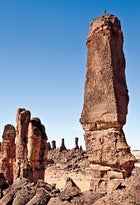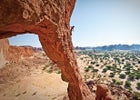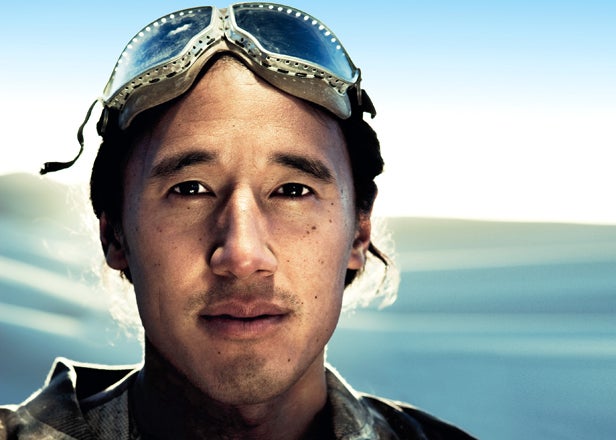I'M CLINGING TO A ROTTEN AND UNCLIMBED SPIRE OF SANDSTONE 200 FEET ABOVE AFRICA'S ENNEDI PLATEAU, IN CHAD, NEAR THE EASTERN BORDER WITH SUDAN. Below and in every direction sweeps the emptiness of more than 20,000 square miles of landÔÇöVermont and my native New Hampshire combinedÔÇöpreviously unexplored by climbers. There's 50 feet of vertical between me and the spindly summit, where 24-year-old James Pearson, one of Britain's boldest young rock climbers, sits belaying. Virgin sandstone like this is brittle, so I gingerly pull with my left hand on a flake the size of a dinner plate. It flexes andÔÇöpop!ÔÇösnaps off, filling my eyes and mouth with rock dust. At nearly the same moment, both of my footholds crumble and I'm left dangling by my right hand.
James Pearson
 James Pearson atop the trip's first climb
James Pearson atop the trip's first climbClimbing Ennedi desert, Chad
 Another first ascent
Another first ascentThat's when I hear a familiar chuckle and look over my shoulder to see photographer Jimmy Chin, 37, spinning lazily on a rope about five feet behind me. “That looks sick,” Chin deadpans as he alternates between snapping still photos and shooting video with his digital SLR. Looking down between my legs, I spot photographer and 5.14 sport climber Tim Kemple, 30, who just captured my Cliffhanger maneuver from the ground. And half a mile away, there's Boulder, Colorado, alpinist Renan Ozturk, 30, barely visible on the roof of a jeep, rolling tape on the wide-angle view filmmakers call the establishing shot.
No, we're not making a commercialÔÇöwell, not exactly. The three men behind the cameras, led by Jimmy, with whom I've climbed for more than a decade, make up Camp 4 Collective, an independent production company that's ushering in a new style of expedition coverage and marketing. Thanks to their unique combination of athletic talent and artistic sensibility, plus breakthroughs in digital technology, the trio can rapidly craft films as slick as anything coming from Madison Ave┬şnueÔÇöbut with serious adventure cred.
Just as significant as their creative process is their roster of clients, which is made up almost exclusively of major gear brands. Expedition chronicles have classically been published by media outlets like ║┌┴¤│ď╣¤═° and National Geo┬şgraphic, whether in print, on television, online, or all of the above. But in the Facebook and YouTube era, outdoor companies have begun building their own internal media machines to reach consumersÔÇöand readers and viewersÔÇödirectly. Here in Chad, Camp 4 is on assignment for The North Face (TNF), which, as it happens, also sponsors me, James, and the expedition's third official climber, Alex Honnold, best known for his 2008 ascent of Yosemite's Half Dome without a rope. Every day, the Camp 4 guys transfer their footage to laptops and, via satellite modem, upload still images and blog posts to TNF's website. When they get back, they'll select photos and piece together clips that North Face marketers will blast at wide-ranging targets, from the company's 800,000 social-media fol┬şlowers to its 200 retail outlets to Korean movie theaters to billboards in New York City.
Fine by meÔÇöI can still get paid to take epic climbing trips. But as I realize more every day in Chad, the new formula means that sponsored athletes are no longer on top of the adventure heap. That spot has been claimed by the chuckling guy on the rope behind me who keeps politely offering stage directions.
Spitting out sandstone, I paste my feet back onto the rock and resume climbing. Just below the summit I hesitate, allowing Jimmy to get into position. When he gives the signal, I throw a leg over the lip, stand up, and slap hands with James in a triumphant G.I. Joe grip. I stare out into the infinity beyond Jimmy's lens, pretending it's not there.
“That was perfect,” he says. “But can I get you guys standing over on that edge, so Renan can get this on the long shot?”
EXPEDITION REPORTING HAS COME a long way since Mallory was dispatching letters with carriers in the 1920s. In 1953, news of Sir Edmund Hillary and Tenzing Norgay's Everest ascent took four days to make it into London's Guardian newspaper. Thirty years later, in 1983, high-altitude filmmaker David Breashears broadcast the first live TV images from Everest's summit.
Everything changed again in the mid-nineties with the development of mobile satellite phones and the rise of the Internet. Suddenly, expeditions were being covered in close to real time by startups like Quokka Sports and MountainZoneÔÇöwhich sounded awesome until you actually went on one of their trips. Quokka spent close to $100,000 in 1999 to send me, Durango, ColoradoÔÇôbased Jared Ogden, and the late Alex Lowe, considered the world's best alpinist at the time, to scale the 20,624-foot Great Trango Tower, in Pakistan's Karakoram Range. The three of usÔÇöall sponsored by TNF, which ponied up about $30,000ÔÇöwere accompanied by two highly skilled climbing filmmakers.
Trango was billed as the next frontier in expedition coverage. Each day after crawling into our portaledge, we'd pull out our mini laptops and create dispatches that included journal entries, photos, and choppy videoÔÇöthen beam everything down to base camp with a radio modem. Things went badly almost from the start. Alex got sick and had to descend to a lower elevation to speed his recovery. Before he left, he filed a quick post: “There's a bad vibe in camp.”
He was mostly pissed at me. Later, I confessed in my online journal to feeling like we were frauds: “Alex and I have been arguing about some really dumb shit. Sadly, we realized that we've never climbed together just for fun. Everything we've done together has been in front of the camera, and this has made it hard for us to be ourselves.”
As the trip progressed, so did the bickering. “We were reduced to communicating with each other through a website,” says Jared. It ended up playing out like a crude version of SurvivorÔÇöwhich was actually the point. Brian Terkelsen, Quokka's Trango producer, had co-founded the Eco-Challenge in 1993 with Survivor mastermind Mark Burnett. The two had spent years developing reality-TV formulas that centered on relationship dynamics. “On Survivor, people say one thing to your face, then do their 'confessional' to the camera,” says Terkelsen, now the president of a New York ad agency. “Trango was the exact same, but more raw and real.”
The low point for me came as I dangled thousands of feet off the ground while a Quokka desk jockey back in San Francisco berated me over my handheld radio. I had a bad attitude, he told me, and could I work a little harder?
Some climbers watching from the outside were even more disappointed. American alpinist Steve House criticized our approach in the 2000 American Alpine Journal, writing that “sponsor┬şships involving heavy use of cameras, web sites and films are incompatible with modern, lightweight tactics.”
That kind of Luddite sentiment has since dissipated as digital-video equipment got simultaneously very good and very light. Meanwhile, the whole world has taken to watching short film clips onlineÔÇödirtbag climbers included. Grunts like me still have to perform for the camera, but we've been griping about what we call the dog-and-pony show since the earliest days of expedition sponsorship. The truth is that we're happier than we've ever been with the imagery because other climbers are now driving the creative process. The fact that Camp 4 takes its orders from our sponsors only makes us more relaxed:ÔÇłtheir job is to make us look good.
“Everybody who's involved with the producing, writing, and directingÔÇöwe're all athletes,” says Jimmy. “We understand when it's OK to set up shots and have people redo stuff and when it's time to hammer and climb. We understand the athletes because we are the athletes.”
I FIRST HEARD ABOUT the Ennedi from an Italian climber who'd visited the Tibesti Mountains, in the north, in the late nineties. I scouted out the region on Google Earth and found online photos that confirmed the area was loaded with sandstone towers. Then I called Jimmy, who saw the potential of the place and signed on. I pitched the trip to TNF's expedition committee, they bit, and last November, off we went.
In the capital city of N'Djamena (population one million), our fixer, a 66-year-old Italian expat named Piero Rava, helped us load our gear into the backs of two Toyota Land Cruisers and a Range Rover. We set off on one of the country's only paved roads, rolling by little shops and mud houses that dotted the flat clay world. We had been on the road for less than an hour when Piero punched a few buttons on his GPS, jerked the wheel to the east, and careered off into the desert. “This is my way to the Ennedi,” he explained.
Over the next four days, we ripped across 400 miles of desert ending in a labyrinth of sandstone towers, arches, and canyons. We spent a night at the base of a 200-foot tower, and in the morning, James racked up the aluminum camming devices and stoppers that he'd place into cracks in the rock to protect our falls. Alex, always the soloist, set off to climb some surrounding towers without any protection at all.
Meanwhile, Jimmy and Tim scaled nearby formations to get different camera angles, and Renan set up a 20-foot-tall aluminum jib crane at the base of the route that would pan around us as we climbed. In 30 minutes, Camp 4 had established a mobile studio. As Jimmy sees it, a fast and light team makes a project like this authentic.
“If you're shooting with a big production company, you're making a movieÔÇöyou're not on an expedition,” he says.
Later, we settled in around a plywood table. James tapped out a blog post while the Camp 4 guys transferred footage onto hard drives. I sat behind Renan and sipped vodka as he watched the day's footage and pulled out still frames to upload.
At around 10 P.M., I crawled woozily into my sleeping bag just as Jimmy and Renan were heading out to set up an overnight time lapse. Next thing I knew, it was 4 A.M. and Jimmy was shaking me awake. It was time to reenact our first ascent, in the perfect light. Jimmy hadn't slept.
BEFORE HE COFOUNDED CAMP 4, Jimmy had established himself as his generation's preeminent adventure photographer, capable of capturing beautifully composed images while climbing and skiing EverestÔÇöand cracking jokes the entire time.
Born in 1973 in Mankato, Minnesota, the second child of Chinese immigrants, he'd been a precocious kid: classical violin at age four, fluent in Chinese and English, straight A's. After graduating from Carleton College in 1996, though, he took a year off rather than go on to grad school as his parents wanted.
A year turned into two, then three, as Jimmy fell in with the climbers of Yosemite National Park's famed Camp 4, the longtime dirtbag nexus and now the namesake of his company. One morning in April 1999, after completing a route on El Capitan, Jimmy and his climbing partner Brady Robinson were camped at the summit. In an act that's become something of a legend among climbers, Jimmy woke up, noticed the nice light, and grabbed Robinson's camera to snap a photo of him while he slept. Robinson sold the shot to the gear maker Mountain Hardwear for $500, which he handed over to Jimmy.
“It was like, I only have to take one photo a month and I can be a climbing bum for the rest of my life,” says Jimmy.
He used the cash to buy a camera, which he took on climbing trips to Pakistan. Back in the States, he sold more photos to Mountain Hardwear, and his work caught the eye of Conrad Anker, a longtime TNF climber. After a trip together in Pakistan, Anker invited Jimmy, then 30, on a 2002 trek across Tibet's Chang Tang Plateau. The team included the late climber-photographer Galen Rowell, who was Jimmy's hero and mentor; alpinist Rick Ridgeway, a member of the team that made the first American ascent of K2; and David Breashears, famous for his Everest Imax movie. When Breashears dropped out, Jimmy became the cinematographer. “Commit and you'll figure it out,” Ridgeway told him.
After seeing Jimmy's footage, Breashears hired him on a 2004 Everest trip to film and shoot stills that ended up in the PBS documentary Storm Over Everest. Jimmy had his own Quokka moment that year with the Rush HD cable channel on a climbing trip to Mali. “The cameramen were awesome guys, but the directors and producers didn't get it,” recalls Jimmy. They kept trying to dictate where and how the team would climb. “It became the tail wagging the dog.”
By 2005, he was the go-to photographer for major climbing media projects. That year, he photographed five expeditions, including Ed Viesturs's final 8,000-meter-peak ascent, on Annapurna. Jimmy was soon able to split his downtime between his new home outside Jackson Hole, Wyoming, and a surf cabana in Sayulita, Mexico.
Jimmy's evolution to climber-filmmaker-producer was enabled by monumental leaps in camera technology. In 2008, Canon and Nikon started packing the power of HD video into the compact digital SLRs carried by adventure photographers. “It used to be that you needed a $100,000 camera that weighs 40 pounds to make nice video,” says Jimmy. “All of a sudden we could shoot films with the same equipment.”
Jimmy and Tim, who'd been photographing ads for TNF for several years, were already running in the same circles. Renan had made a name for himself as an artistic rock rat, hitchhiking the West, completing alpine-style ascents of big walls and drawing expansive scenes of it in his sketchbooks. He became a TNF athlete in 2005 and that spring joined Jimmy and Conrad Anker for a climb of India's Meru Central, during which Jimmy taught Renan how to shoot movies.
The decision to create a joint production house came at a TNF staff meeting. “Every company from TNF to a real estate firm needs short-form video work,” explains Jimmy. “It allowed us to take on bigger projects.”
They pooled their equipment, filed articles of incorporation, and became Camp 4 Collective. They had the luxury of a built-in client with TNF but quickly racked up commercial shooting gigs for one of Jimmy's other sponsors, Revo sunglasses, and the outdoor retailer Eastern Mountain Sports. They got so busy so fast that it wasn't until Chad that all three of them were able to work on a project together.
EVERY COUPLE of days in Chad, Piero would drive us to a new zone, and slowly we worked our way deeper into the Ennedi. On day 13, we crested a rise and, for the first time, could see the edge of the Sahara, where the canyonlands ended and undulating sand dunes stretched out toward Sudan.
A few days later, Piero led us up a slot canyon and parked below Aloba Arch, one of the world's tallest natural bridges. The walls of the canyon soared 700 feet above us, and across the top a 50-foot-thick slab of streaked sandstone spanned the 300-foot gap. Honnold, who had climbed the under┬şside of a smaller arch the day before, was sali┬şvating, but there were hardly any cracks that would allow for protection.
We were absorbed in a discussion of possible routes when five young men wearing long white robes and head scarves materialized out of the canyon. They immediately started yelling at us in Arabic. None of us had any clue what they were saying, but it became obvious what they wanted when one of them grabbed Renan's pack containing $10,000 worth of camera gear. When Renan snatched it back, the kid unsheathed a knife and began lunging while pounding his fist into his chest. They had us corralled inside the slot canyon, and there was no escape.
The same kid then approached Jimmy and snatched his sunglasses. Renan had pulled out his camera and was filming everythingÔÇöwhich was definitely not helping to diffuse the situation. Jimmy picked up a softball-size rock and held it up menacingly. I grabbed a gnarled tree branch and moved to his side. We stared at the youths, and you could see it dawn on them that we weren't going down without a fight. Suddenly the kid put the sunglasses down. Seconds later the youths vanished the way they had come.
Back at the vehicles, Renan showed us the footage he'd captured. Somehow he had managed to hold the camera steady while Knife Guy lunged and put on a display. The focus and framing were perfect, and the sun glinted off the point on the dagger.
“That's definitely going in the film,” Jimmy said as he slipped his shades back on and settled into the Land Cruiser.


